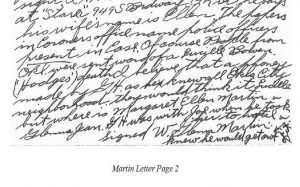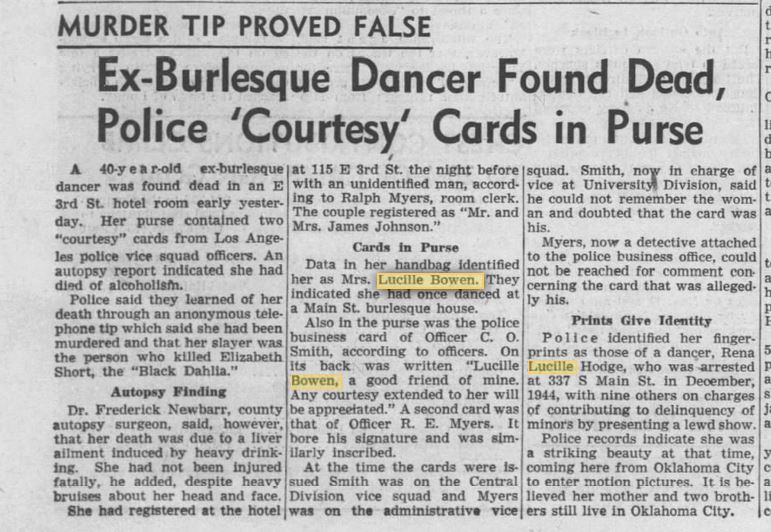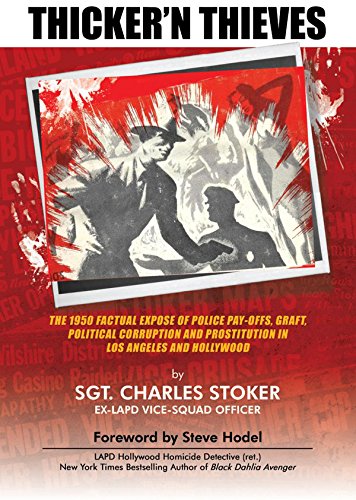Update on Police Informant W. Glenn Martin Letter – Los Angeles Times Article Suggests Letter Written on October 26, 1949 – Lucille Bowen in Martin Letter a New Murder Victim or Natural Death? – Judge for Yourself
November 2, 2018
Los Angeles, California
I originally reported the LAPD police informant W. Glenn Martin Letter appeared to be written on October 25th (written over Oct 26) but I have located the article he referenced in the newspaper and it is apparently from the Los Angeles Times, dated October 26, 1949.
Martin in his letter makes two separate references to the article shown below:
…”I saw in paper where a girl had been murdered at 116 E 3rd St. an unidentified body plus other conditions mentioned in paper.

Martin later in his letter then writes:
…Of course people from Okl. were sent word of a Lucille Bowen (Hodges) death I believe that a phoney made by G.H. as he knew all Okla City neighborhood. They would think it Lucille but where is Margaret Ellen Martin & Glenna Jean. G.H. was with Joe when he took her to hotel & knew he would get out of it.
Signed W. Glenn Martin

Here is a copy of the Los Angeles Times article of October 26, 1949:

The information contained in the LAT article both answers and raises questions as relates to Glenn Martin’s letter. Here are some bullet points:
- Victim was Rena Lucille Hodge, aka Lucille Bowen, age 40.
- Lucille and an unidentified male checked into the hotel at 115 E. 3rd St by hotel clerk Myers who registered them as “Mr./Mrs. Johnson.” (As presented in BDA I) I present evidence that a male who I believe was later ID’d as George Hodel, and Elizabeth Short checked into a hotel on East Washington Blvd on January 12, 1947. The hotel owners who checked them in were a Mr./Mrs Johnson, reported to police the male returned the day of Elizabeth Short’s murder and nervously checked out. His photo was identified by the Johnson’s as “a man connected to a foreign government.” As summarized in BDA I believe the photo shown was GHH’s UNRRA photo, where he is seen standing with Chinese government officials. Mr./Mrs. Johnson’s name and photographs were prominently displayed in LA local newspapers in 1947 as important witnesses.
- An anonymous caller (not Glenn Martin) calls the police and informs them that the victim is at the hotel and “has been murdered and her killer is the same man who killed the Black Dahlia.” (George Hodel made numerous telephone calls to press and police informing them of his crimes in LA, Chicago, and San Francisco, prior to and shortly after the bodies were discovered.)
- “Courtesy Cards” from both LAPD Central Vice and Administrative Vice were found in her purse indicating she had close connections to both Vice Divisions. (At the time her body was found LAPD Vice detectives were undergoing major scandals which were actively being investigated by Glenn Martin’s “Lt. McCauley.” Major corruption cases were before the courts and the Grand Jury and LAPD Vice officers were on trial for corruption.)
- The victim, at the time of her death was found “to have heavy bruising about her head and face”, but despite those injuries her cause of death was allegedly found to be “due to alcoholism.” (No apparent follow-up information on either the “tipster” that called in her “murder” or the man “Mr. Johnson” that checked in with her at the hotel were released to the public.
(SKH Note- Taking into consideration the time and conditions in Los Angeles in October, 1949, and the tremendous pressure that the LAPD and the politicians were undergoing from both the 1949 Grand Jury and the public, it is very conceivable that given the choice of calling a suspicious death a murder or a natural –that is a suspicious death with a beating and trauma, that could or could not have caused death, all things being equal, the coroner would most probably go for the non-homicide. “Natural causes due to alcoholism.” Last thing they would want was another “Lone Woman Murder” on the heels of the Louise Springer killing just months prior that they were looking at as being possibly “Black Dahlia” related. Now a new crime that the “tipster” is saying is “Dahlia connected, I did it.” NO WAY.)
For those that think I have “an active imagination” Let me quote directly from LAPD Vice Sgt. Charles Stoker’s book, Thicker’N Thieves, written at the exact same time LAPD undercover informant, Glenn Martin was working for Inspector William H. Parker and Sgt. Kenneth McCauley in their newly established Internal Affairs Divison. October 1949. (Sgt. Stoker has just finished testifying in secret before the 1949 Grand Jury on LAPD Vice corruption and has named names resulting in multiple police officers indictments. He was Serpico twenty-years before Serpico.) SKH Note- Stoker’s book was virtually unattainable and so scarce that copies of his original 1950 edition were selling for $300-$500 a copy on Ebay. Because of his books historical importance I republished it verbatim, as he wrote it, in 2011 and only added an Introductory Chapter and photographs to introduce Sgt. Stoker to Angelenos some five decades later. It is now available on line for $8.00.

Thicker’N Thieves Page 162– (Inspector Parker has called Sgt. Stoker in to his suite at the Biltmore Hotel and wants him to join his newly formed Internal Affairs Division.)
…
After these pleasantries, Parker asked what I knew about the Brenda Allen investigation in Hollywood. When I related the story as I had told
it to the grand jury, he indicated that it was as he had suspected, since he knew positively that there were two sources of corruption in the
police administration.
According to Parker, one source was controlled by Chief of Police Clemence B. Horrall. Aligned with him as a lieutenant was Sergeant Guy Rudolph, his confidential aide. He then related this story concerning Rudolph, which I have never verified.
For years, while Bowron was in office, Rudolph had controlled the vice pay-offs in Los Angeles, and when Horrall held the chief’s job,Rudolph was under his wing. At one time, Rudolph had kicked a colored prostitute to death on Central Avenue; and during the investigation of that incident, he and his partner had gone to a local downtown hotel where they engaged in a drunken brawl with two women. Then, while Rudolph was out of the room buying a bottle of whiskey, one of the prostitutes had been killed.
He asked me if I had heard the story. When I replied that I hadn’t, Parker told me that he could prove what he had related to me. He added that Rudolph also controlled the lottery and numbers rackets operated by Chinese and Negroes, and that he had a Chinese as a partner, and maintained a business office on San Pedro Street.
Armed with this additional information, to my mind it sheds a slightly different light on the writing/reading of W. Glenn Martin’s letter.
It sounds to me that Martin may be concerned that the initially “unidentified female victim at the hotel room” just might be one of his daughters, either Margaret Ellen or Glenna Jeans? He writes, “They would think it Lucille but where is Margaret Ellen Martin & Glenna Jean.” He’s clearly worried.
Worried enough to immediately, that same day, write out his “In Case of the Death of Margaret Ellen or Glenna Jean’s” letter. Clearly, fearful that if “GH” hasn’t already harmed one of them he may do so in the future to get revenge on Martin for connecting him to the Springer and Dahlia crimes.
Ironically, the hotel where “Mr. and Mrs. Johnson” registered at and where the victim’s beaten and bruised body was found the following morning was- THE ST. GEORGE HOTEL.
INVESTIGATION CONTINUED.
An essential up-date from the case that just won’t be ignored. (Thanks to your efforts of keeping it alive and relevant in todays topsy-turvy world) With each new revelation I can understand the reality of this case in greater detail and a fuller understanding of the city politics that helped obscure it’s truthful conclusion. You not only keep digging but you continually mine gold from unknown archives whose pieces of the puzzle you fit into an articulate argument for George Hill Hodel’s quilt. Well Done!
Dennis E: Thanks Dennis. As you know, being an LA Historian, understanding the time and place is critical to seeing how the pieces fit into place. Sgt. Charles Stoker’s book really helps us understand and separate fact from fiction back in the true-life L.A. Confidential of the late Forties, early Fifties. Thanks for you continued support. Steve
This certainly does look like a death whitewashed by someone, at least in part by the surgeon. Journalistic standards were lax in that era, though less at the Times than at other LA papers. Ms. Hodge certainly did not die from “liver disease brought on by alcoholism” at age 40, even if she also had chronic viral hepatitis. A death from acute liver failure would be preceded by symptoms, including delirium/confusion and likely loss of balance (ataxia), that would be highly unlikely to escape notice when she entered the hotel or as she died. Many physicians at that time did hold now-disproven theories about the toxicity of alcoholism to the liver, but I still don’t believe that Dr. Newbarr could have reached the stated conclusion through autopsy alone. He could obviously have concluded this for some corrupt purpose, but indifference is at least as plausible as intentional deception or malice. In those days, a patient’s known alcoholism was commonly cited as causative by doctors more interested in closing a case than in investigating it. I know that many physicians did this when speaking to family members (or, to patients pre-mortem), so I would assume they might tell a reporter a similar story. On top of all these caveats, it’s not clear how the examiner could even have concluded that the trauma was any less likely than liver disease to have caused her death, llet alone that trauma could be excluded definitively. The suspicious circumstances would have aroused further suspicion of a non-accidental death, but both the stated cause and the facile exclusion of trauma appear inconsistent with that.
She could, in principle, have died of acute alcohol intoxication (though I doubt it) or of delirium tremens, but both are unlikely. DT sufferers are typically miserable for hours or days and rarely die quietly. No mention of a seizure was made, and signs would have been evident on autopsy, at least, and likely also by whomever discovered her body.
My assuessment is that this was intentional BS .
Matt S: Yes, I agree. Highly suspicious.
Steve, I agree with your assessment as that is also the way I had interpreted those few sentences in Glenn’s letter. Additionally, I believe that the woman’s body he went to view at the morgue the following a.m. (Oct 27) was that of Lucille Bowen, in an effort to see if it was his daughter, Margaret. He states in his letter, “her face was beaten so badly, hardly recognizable. I nearly came sick at sight.”
Considering the date of the newspaper article, and considering it was the next day that Glenn states in his letter that he visited the morgue in the a.m., I now believe it is possible that the date of his letter is more reflective as to the time frame that Glenn was documenting; to include the evening that G.H. was sitting at his dinner table and also accepting phone calls at Glenn’s house, as opposed to the exact date that he penned the letter.
Hope you are well.
Hi Sandi: I am well thank you. Yes, I agree. So many spokes in this wheel and sadly so many victims.
Thank you again for sending me the information documenting all of this. Been a huge help in trying to get so many unanswered quetions. All my best to you and yours. Stay tuned, more to come. Steve
Hi,
Something turned me on to the Black Dahlia case last night, and now I just can’t stop reading all of this interesting material, whether about her, your father, or these other various murders. But there’s one thing that I can’t figure out, and it may simply be that I haven’t yet come across something that may explain it better. Again, I just began diving into all of this. So I’ll just ask. Glenn Martin stated that G.H. told him that he would “get even” with him…and Glenn then feared for his daughters safety. This is where I’m a bit confused. What exactly was G.H. upset about (regarding Glenn)? And I guess a second and maybe separate question might be…if he was upset with him and had stated that he was going to “get even”…why were they dining together with Glenn’s mother? Again, I’m sure I missed this somewhere, but I’d love a little clarification if you have a free minute…or if anyone else has a minute (and knows the story). Thanks ahead, and I’m really enjoying reading about all of your discoveries.
Carolyn:
I think that GHH only “suspected” that Glenn Martin may have said something to the police, which he clearly had not.
In the letter he say’s that “GHH threatened to get even with me” but I had nothing to do with it.” So, he writes the letter while GHH is nearly ending his Incest Trial in late December 1949, and seals it “To Be Opened In Case of Death or Harm” to either of his daughters. No harm came to either one of them, so letter never opened or passed on. That’s my read of it. steve
Hello Steve,
I’m sure you’re aware of the theories that suggest the killer was a Cleveland doctor checking himself in and out of mental hospitals on a voluntarily basis when investigations were heating up.. Eliot Ness actually investigated this suspect and believed this suspect not only committed all of the Cleveland Torso Murders in the 1930’s, but moved to California and committed the Black Dahlia murder as well. Did your father ever have any connection to Cleveland in the 1930’s?
Rob T:
A number of readers have mentioned the suspected connection between the Dahlia and Cleveland Torso Killer.
Personally, I don’t see it. As I recall most of those victims were males and no indication that my dad
spent that kind of time in Cleveland. My dad was pretty busy fulltime here in Calif/LA area then.
I’m just now learning about the BD case- but I am so intrigued and just want to learn more! I’m from Indianapolis – interested in the connection to Indiana as well as what ever happened to the informant. Did anything ever happen to Margaret or Glenna?
Taylor;
No nothing happened to either of his daughters other than being taken in and questioned.
No harm came to the informant, and as you know, his “letter” was never found/opened until long after his death, found in Sandi Nichols mother’s personal effects after her death. Suggest you read BDA III for complete presentation surrounding Sandi’s discoveries and my followup.
https://www.amazon.com/Black-Dahlia-Avenger-III-Presenting-ebook/dp/B07K8M3ST8/ref=sr_1_1?crid=E4X15TME4HSV&dib=eyJ2IjoiMSJ9.Ia7vamlolP9ZQ5KgatkaaOcGLK0UgpgEdDCSjepH5cpF63thxNvBzVXEllHVAo5yH1avTuYHFhQUTHsnQcMWJ2JvAk4gXV_PkxhZcOJjCyzb0aQr_UafUVAW8PUMe0XsAlEJfkPnJez-YyXxh5AvbE02daz1ElMl_QPoKQgB9Mr949n-7nTdai3nFQ0ecbltWgFkh3v3Zy_lLGqAyCQzcWCmq5fB8W2bhmzDxIm8-C4.Axwi_v_OiUfT0gPHI5DpQlEBTkPRD3-tYIyEFjjOW4Y&dib_tag=se&keywords=black+dahlia+avenger+III&qid=1711635882&sprefix=black+dahlia+avenger+iii%2Caps%2C189&sr=8-1